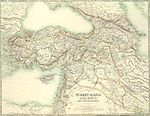Hattians
| History of Turkey |
|---|
 |
| Timeline |
|
|
The Hattians (
Terminology

Complex questions related to
It is therefore assumed that Hattian designations had some special significance already during the pre-Hittite period, and it is also accepted, as a
The use of the term "Proto-Hittite" as a designation for Hattians is inaccurate. The
History
Several
A
The Hattians were organized in
Language
Hattians spoke the
Evidence of a 'Hattic' civilization is provided by the remnants of one of the non-Indo-European languages found in the later Hittite archives. The language is identified in several of the texts in which it appears by the term hattili- '(written) in the language of Hatti.' The few texts that survive are predominantly religious or cultic in character. They provide us with the names of a number of Hattic deities, as well as Hattic personal and place-names.[14]
About 150 short specimens of Hattian text have been found in Hittite cuneiform clay tablets. Hattian leaders perhaps used scribes who wrote in Old Assyrian. Ekrem Akurgal wrote, "the Anatolian princes used scribes knowing Assyrian for commerce with Mesopotomia as at Kanesh (Kültepe)" to conduct business with Assyria.[15] From the 21st to the mid-18th centuries BC, Assyria established trade outposts in Hatti, such as at Hattum and Zalpa.
Scholars have long assumed that the predominant population of the region of Anatolia "in the third millennium [BC] was an indigenous pre-Indo-European group called the Hattians." Another non-Indo-European group were the Hurrians.[16] But it is thought possible that speakers of Indo-European languages were also in central Anatolia by then. The scholar Petra Goedegebuure has proposed that before the conquest of the Hittites, an Indo-European language, probably Luwian, had already been spoken alongside the Hattian language for a long time.[17]
Hattian became more ergative towards the New Hittite period. This development implies that Hattian remained alive until at least the end of the 14th century BC.[18]
Alexei Kassian proposed that the
Religion

Hattian religion may be traced back to the Stone Age. It involved worship of the earth, personified as a
Later on the
The Hittite legends of
See also
- Hattian language
References
- ^ Akurgal 2001, p. 4-6.
- ^ Bryce 2005, p. 12-15.
- ^ Bryce 2009, p. 297-298, 314.
- ^ Bryce 2009, p. 297-298.
- ^ Bryce 2014, p. 129.
- ^ Akurgal 2001, p. 38.
- ^ Bryce 2005, p. 25.
- ^ Bryce 2005, p. 10.
- ^ Bryce 2009, p. 297.
- ^ Gilan 2010, p. 53.
- ^ Gilan 2018, p. 7.
- ^ Barjamovic 2011, p. 292-297.
- ^ Burney 2004, p. 106-107.
- ^ Bryce 2005, p. 12.
- ^ Akurgal 2001, p. 5.
- ^ Bryce 2005, p. 12-13.
- ^ Petra Goedegebuure 2008 Central Anatolian Languages and Language Communities in the Colony Period: A Luwian-Hattian Symbiosis and the independent Hittites. OAAS volume 3 Leiden
- ^ Published in Proceedings of the 53e Rencontre Assyriologique Internationale Vol. 1: Language in the Ancient Near East (2010)
- ^ Kassian, Alexei. 2009. Ugarit Forschungen Band 41, 403
- ISBN 978-0-7614-7559-0. Retrieved 26 March 2013.
- ^ Burney 2004, p. 106.
- JSTOR 3270383.
- ISBN 978-1-57506-069-9.
- ^ Akurgal 2001.
Sources
- ISBN 9789751727565.
- ISBN 9788763536455.
- Beckman, Gary M. (2001). "Sargon and Naram-Sin in Ḫatti: Reflections of Mesopotamian Antiquity among the Hittites"(PDF). Die Gegenwart des Altertums: Formen und Funktionen des Altertumsbezugs in den Hochkulturen der Alten Welt. Heidelberg: Forum. pp. 85–91.
- ISBN 978-0-19-927908-1.
- ISBN 9781134159079.
- ISBN 9781444337341.
- ISBN 9780810865648.
- Gilan, Amir (2010). "Epic and History in Hittite Anatolia: In Search of a Local Hero". Epic and History. Chichester: John Wiley & Sons. pp. 51–65. ISBN 9781444315646.
- Gilan, Amir (2018). "In Search of a Distant Past: Forms of Historical Consciousness in Hittite Anatolia" (PDF). Anadolu. 44: 1–23.

